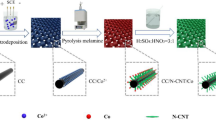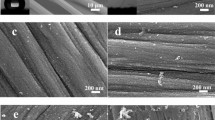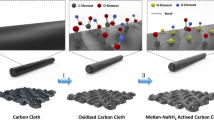Abstract
Electrochemical cyclic recharging of a binder-free flexible carbon material in respect to supercapacitor applications is reported. To provide high enough and stable pseudocapacitance, the surface of carbon nanotube cloth (CNTC) was exposed to dry oxidative functionalization by annealing in air at 460 °C. We report the effect of annealing time (0.5–3 h) on capacitance, electrical resistivity and specific surface area. CNTC annealed for 1 h demonstrated the best results: the capacitance of ca. 42 F g−1 in 0.5 M H2SO4 (slightly decreasing with a scan rate up to 1000 mV s−1) and specific resistivity of 20 µΩ m. For CNTC demonstrating these characteristics, the specific surface area was 342 m2 g−1, comprising almost from mesopores. Capacitance retention of 99.1% during 30,000 recharging cycles was observed. Finally, a flexible symmetric supercapacitor operating at 1 V was assembled from the freestanding (unsupported) CNTC electrodes to test their performance in a device prototype. Coulombic efficiency was close to 100% at high enough current densities. Our observations allow to consider air-oxidized CNTC as a promising electrode material for flexible supercapacitors.
Graphical abstract






Similar content being viewed by others
References
Becker HI (1957) Low voltage electrolytic capacitor. Pat. US2800616.
Chen X, Paul R, Dai L (2017) Carbon-based supercapacitors for efficient energy storage. Natl Sci Rev 4:453–489. https://doi.org/10.1093/nsr/nwx009
Raghavendra KVG, Vinoth R, Zeb K, et al (2020) An intuitive review of supercapacitors with recent progress and novel device applications. J Energy Storage 31:101652. https://doi.org/10.1016/j.est.2020.101652
Sharma P, Kumar V (2020) Current technology of supercapacitors: a review. J Electron Mater 49:3520–3532. https://doi.org/10.1007/s11664-020-07992-4
Zhao J, Burke AF (2021) Electrochemical capacitors: materials, technologies and performance. Energy Storage Mater 36:31–55. https://doi.org/10.1016/j.ensm.2020.12.013
Volfkovich YM (2021) Electrochemical supercapacitors (a review). Russ J Electrochem 57:311–347. https://doi.org/10.1134/S1023193521040108
Andreas HA, Conway BE (2006) Examination of the double-layer capacitance of an high specific-area C-cloth electrode as titrated from acidic to alkaline pHs. Electrochim Acta 51:6510–6520. https://doi.org/10.1016/j.electacta.2006.04.045
Centeno TA, Stoeckli F (2006) The role of textural characteristics and oxygen-containing surface groups in the supercapacitor performances of activated carbons. Electrochim Acta 52:560–566. https://doi.org/10.1016/j.electacta.2006.05.035
Centeno TA, Stoeckli F (2006) On the specific double-layer capacitance of activated carbons, in relation to their structural and chemical properties. J Power Sources 154:314–320. https://doi.org/10.1016/j.jpowsour.2005.04.007
Zhu S, Ni J, Li Y (2020) Carbon nanotube-based electrodes for flexible supercapacitors. Nano Res 13:1825–1841. https://doi.org/10.1007/s12274-020-2729-5
Hillier N, Yong S, Beeby S (2020) The good, the bad and the porous: a review of carbonaceous materials for flexible supercapacitor applications. Energy Rep 6:148–156. https://doi.org/10.1016/j.egyr.2020.03.019
Zhang Y, Mei H, Cao Y, et al (2021) Recent advances and challenges of electrode materials for flexible supercapacitors. Coord Chem Rev 438:213910. https://doi.org/10.1016/j.ccr.2021.213910
Xie P, Yuan W, Liu X, et al (2021) Advanced carbon nanomaterials for state-of-the-art flexible supercapacitors. Energy Storage Mater 36:56–76. https://doi.org/10.1016/j.ensm.2020.12.011
Cheng C, He S, Zhang C, et al (2018) High-performance supercapacitor fabricated from 3D free-standing hierarchical carbon foam-supported two dimensional porous thin carbon nanosheets. Electrochim Acta 290:98–108. https://doi.org/10.1016/j.electacta.2018.08.081
Zaccagnini P, di Giovanni D, Gomez MG, et al (2020) Flexible and high temperature supercapacitor based on laser-induced graphene electrodes and ionic liquid electrolyte, a de-rated voltage analysis. Electrochim Acta 357:136838. https://doi.org/10.1016/j.electacta.2020.136838
Dai P, Zhang S, Liu H, et al (2020) Cotton fabrics-derived flexible nitrogen-doped activated carbon cloth for high-performance supercapacitors in organic electrolyte. Electrochim Acta 354:136717. https://doi.org/10.1016/j.electacta.2020.136717
Phattharasupakun N, Wutthiprom J, Suktha P, et al (2017) High-performance supercapacitors of carboxylate-modified hollow carbon nanospheres coated on flexible carbon fibre paper: effects of oxygen-containing group contents, electrolytes and operating temperature. Electrochim Acta 238:64–73. https://doi.org/10.1016/j.electacta.2017.03.208
Filimonenkov IS, Urvanov SA, Zhukova EA, et al (2018) Carbon nanotube cloth for electrochemical charge storage in aqueous media. J Electroanal Chem 827:58–63. https://doi.org/10.1016/j.jelechem.2018.09.004
Mordkovich VZ, Kazennov N V, Ermolaev VS, et al (2018) Scaled-up process for producing longer carbon nanotubes and carbon cotton by macro-spools. Diam Relat Mater 83:15–20. https://doi.org/10.1016/j.diamond.2018.01.017
Karaeva A, Urvanov S, Kazennov N, et al (2020) Synthesis, structure and electrical resistivity of carbon nanotubes synthesized over group VIII metallocenes. Nanomaterials 10:2279. https://doi.org/10.3390/nano10112279
Karaeva AR, Zhukova EA, Urvanov SA, et al (2016) Modification of surface of double wall carbon nano tubes by fullerene C60. Izv Vyss Uchebn Zaved Khim Khim Tekhnol 59:12–20. https://doi.org/10.6060/tcct.20165908.27y
Kinoshita K, Bett JAS (1973) Potentiodynamic analysis of surface oxides on carbon blacks. Carbon 11:403–411. https://doi.org/10.1016/0008-6223(73)90080-8
Thorogood CA, Wildgoose GG, Crossley A, et al (2007) Differentiating between ortho- and para-quinone surface groups on graphite, glassy carbon, and carbon nanotubes using organic and inorganic voltammetric and X-ray photoelectron spectroscopy labels. Chem Mater 19:4964–4974. https://doi.org/10.1021/cm071412a
Gusmão R, Cunha E, Paiva C, et al (2016) Role of carbonaceous fragments on the functionalization and electrochemistry of carbon materials. ChemElectroChem 3:2138–2145. https://doi.org/10.1002/celc.201600399
Kinoshita K (1988) Carbon: electrochemical and physicochemical properties. Wiley, New York, p. 310–312
Seo M-K, Park S-J (2010) Influence of air-oxidation on electric double layer capacitances of multi-walled carbon nanotube electrodes. Curr Appl Phys 10:241–244. https://doi.org/10.1016/j.cap.2009.05.031
LI L, LI F (2011) The effect of carbonyl, carboxyl and hydroxyl groups on the capacitance of carbon nanotubes. New Carbon Mater 26:224–228. https://doi.org/10.1016/S1872-5805(11)60078-4
Chen J, Li C, Lian Y, et al (2021) Understanding the oxygen-containing functional groups on multiwall carbon nanotubes toward supercapacitors. Mater Today Chem 19:100414. https://doi.org/10.1016/j.mtchem.2020.100414
He Y, Zhang Y, Li X, et al (2018) Capacitive mechanism of oxygen functional groups on carbon surface in supercapacitors. Electrochim Acta 282:618–625. https://doi.org/10.1016/j.electacta.2018.06.103
Ryabova AS, Bonnefont A, Simonov PA, et al (2017) Further insights into the role of carbon in manganese oxide/carbon composites in the oxygen reduction reaction in alkaline media. Electrochim Acta 246:643–653. https://doi.org/10.1016/j.electacta.2017.06.017
Rabbow TJ, Whitehead AH (2017) Deconvolution of electrochemical double layer capacitance between fractions of active and total surface area of graphite felts. Carbon 111:782–788. https://doi.org/10.1016/j.carbon.2016.10.064
He Y, Chen W, Gao C, et al (2013) An overview of carbon materials for flexible electrochemical capacitors. Nanoscale 5:8799–8820. https://doi.org/10.1039/C3NR02157B
Lee J, An G (2021) Surface-engineered flexible fibrous supercapacitor electrode for improved electrochemical performance. Appl Surf Sci 539:148290. https://doi.org/10.1016/j.apsusc.2020.148290
Hérou S, Crespo Ribadeneyra M, Schlee P, et al (2021) The impact of having an oxygen-rich microporous surface in carbon electrodes for high-power aqueous supercapacitors. J Energy Chem 53:36–48. https://doi.org/10.1016/j.jechem.2020.04.068
Tanahashi I, Yoshida A, Nishino A (1990) Electrochemical characterization of activated carbon-fiber cloth polarizable electrodes for electric double‐layer capacitors. J Electrochem Soc 137:3052–3057. https://doi.org/10.1149/1.2086158
He D, Marsden AJ, Li Z, et al (2019) A single step strategy to fabricate graphene fibres via electrochemical exfoliation for micro-supercapacitor applications. Electrochim Acta 299:645–653. https://doi.org/10.1016/j.electacta.2019.01.034
Wang M, Ma Y (2017) Nitrogen-doped graphene forests as electrodes for high-performance wearable supercapacitors. Electrochim Acta 250:320–326. https://doi.org/10.1016/j.electacta.2017.08.073
Chen D-Z, Yu J, Lu W, et al (2017) Temperature effects on electrochemical performance of carbon nanotube film based flexible all-solid-state supercapacitors. Electrochim Acta 233:181–189. https://doi.org/10.1016/j.electacta.2017.03.009
Che J, Chen P, Chan-Park MB (2013) High-strength carbon nanotube buckypaper composites as applied to free-standing electrodes for supercapacitors. J Mater Chem A 1:4057–4066. https://doi.org/10.1039/C3TA01421E
Di J, Hu D, Chen H, et al (2012) Ultrastrong, foldable, and highly conductive carbon nanotube film. ACS Nano 6:5457–5464. https://doi.org/10.1021/nn301321j
Jang IY, Muramatsu H, Park KC, et al (2009) Capacitance response of double-walled carbon nanotubes depending on surface modification. Electrochem Commun 11:719–723. https://doi.org/10.1016/j.elecom.2009.01.021
Zheng C, Qian W, Cui C, et al (2012) Hierarchical carbon nanotube membrane with high packing density and tunable porous structure for high voltage supercapacitors. Carbon 50:5167–5175. https://doi.org/10.1016/j.carbon.2012.06.058
Gui X, Wei J, Wang K, et al (2010) Carbon nanotube sponges. Adv Mater 22:617–621. https://doi.org/10.1002/adma.200902986
Li Q, Kuzmenko V, Haque M, et al (2020) Explanation of anomalous rate capability enhancement by manganese oxide incorporation in carbon nanofiber electrodes for electrochemical capacitors. Electrochim Acta 340:135921. https://doi.org/10.1016/j.electacta.2020.135921
Volfkovich YM, Mazin VM, Urisson NA (1998) Operation of double-layer capacitors based on carbon materials. Russ J Electrochem 34:825–832
Subrenat A, Baléo JN, Le Cloirec P, Blanc PE (2001) Electrical behaviour of activated carbon cloth heated by the Joule effect: desorption application. Carbon 39:707–716. https://doi.org/10.1016/S0008-6223(00)00177-9
Liu F, Song S, Xue D, Zhang H (2012) Folded structured graphene paper for high performance electrode materials. Adv Mater 24:1089–1094. https://doi.org/10.1002/adma.201104691
Yun YS, Park Y-U, Chang S-J, et al (2016) Crumpled graphene paper for high power sodium battery anode. Carbon 99:658–664. https://doi.org/10.1016/j.carbon.2015.12.047
Choi BG, Hong J, Hong WH et al (2011) Facilitated ion transport in all-solid-state flexible supercapacitors. ACS Nano 5:7205–7213. https://doi.org/10.1021/nn202020w
Acknowledgements
The authors thank The Ministry of Science and Education of Russian Federation for supporting TISNCM in terms of a state assignment. Alexey V. Panferov and Ivan A. Evdokimov are gratefully acknowledged for the BET characterization of CNTC-[x]h (x = 0, 0.5, 1, 2, 3) samples and ultimate tensile strength measurements of the CNTC-1h sample, respectively. The authors also thank Kirill O. Gryaznov and Aida R. Karaeva for fruitful discussions and help with a number of experiments. The work was performed using the Shared Research Facilities ‘Research of Nanostructured, Carbon and Superhard Materials’ FSBI TISNCM. GTs completed this work in frames of the state target No АААА-А21-121011590088-4.
Author information
Authors and Affiliations
Corresponding author
Ethics declarations
Conflict of interest
All authors declare that they have no conflict of interest.
Additional information
Publisher’s Note
Springer Nature remains neutral with regard to jurisdictional claims in published maps and institutional affiliations.
Supplementary Information
Below is the link to the electronic supplementary material.
Rights and permissions
About this article
Cite this article
Filimonenkov, I.S., Urvanov, S.A., Kazennov, N.V. et al. Carbon nanotube cloth as a promising electrode material for flexible aqueous supercapacitors. J Appl Electrochem 52, 487–498 (2022). https://doi.org/10.1007/s10800-021-01652-z
Received:
Accepted:
Published:
Issue Date:
DOI: https://doi.org/10.1007/s10800-021-01652-z




